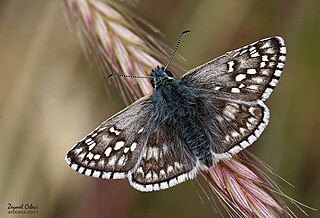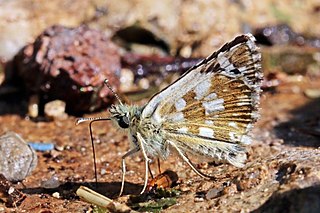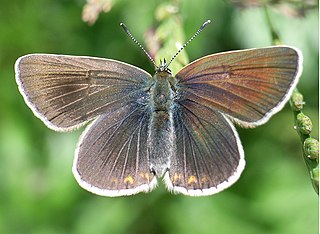
The common footman is a moth of the family Erebidae. The species was first described by Johann Leopold Theodor Friedrich Zincken in 1817. It is distributed throughout Europe and east through the Palearctic to Lake Baikal.

The brown hairstreak is a butterfly in the family Lycaenidae. The range includes most of the Palaearctic.

Pyrgus sidae, the yellow-banded skipper, is a species of skipper. It is found in from the Iberian Peninsula through southern and eastern Europe, southeast France, the northwestern coastal areas of central Italy, then Istria and the Balkan peninsula, across Turkey, Transcaucasia, to Iran and Afghanistan. East of the Southern Ural mountains the range extends to northwest Kazakhstan and the west of the Tien Shan in the north.

The sandy grizzled skipper is a species of skipper. It has a restricted range in southeastern Europe with a small relict population in central Spain.

Satyrium acaciae, the sloe hairstreak, is a butterfly in the family Lycaenidae.

Amblopala is a Palearctic and Indomalayan butterfly genus in the family Lycaenidae. The genus is monotypic containing the single species Amblopala avidiena the Chinese hairstreak. It is a small butterfly found in the Naga Hills of India and in China

Parnassius tenedius, the tenedius Apollo, is an east Palearctic member of the snow Apollo genus (Parnassius) of the swallowtail family (Papilionidae). Populations range from Siberia and the Far East of Russia to the western Chukchi Peninsula, Mongolia and north China. The larva feeds on Corydalis species. In the northern part of its range it is a low altitude butterfly; further south it is montane.

Phytometra viridaria, the small purple-barred, is a moth of the family Erebidae. The species was first described by Carl Alexander Clerck in 1759. It is found in central and southern Europe, Mauritania, Morocco, Algeria, Tunisia, Armenia, Iraq, Iran, Afghanistan, Pakistan, and further east across the Palearctic to southern Siberia.

Spilosoma lubricipeda, the white ermine, is a moth of the family Erebidae. It is found throughout the temperate belt of Eurasia from Europe through Kazakhstan and southern Siberia to Amur Region, China, Korea and Japan. In China several sibling species occur.

Eumedonia eumedon, the geranium argus, is a butterfly of the family Lycaenidae. It is found in the Palearctic realm. This butterfly has been included in the genera Plebejus, Plebeius, Polyommatus and Aricia, but recent molecular studies have demonstrated that Eumedonia is a valid genus, different from the previous genera mentioned.

Calliteara pudibunda, the pale tussock, is a moth of the family Erebidae. The Dutch common name for the moth (Meriansborstel) comes from the butterfly and insect painter Maria Sibylla Merian. The species was first described by Carl Linnaeus in his 1758 10th edition of Systema Naturae. It is found in Asia and Europe.

Synthymia is a genus of moths of the family Noctuidae. It contains only one species, Synthymia fixa, The Goldwing, which is found in southern Europe and North Africa.

Satyrium mera is a butterfly of the family Lycaenidae. It is endemic to Japan. The larva on feeds on Rhamnus (Rhamnaceae). Satyrium mera is single brooded and overwinters as an egg.

Hipparchia neomiris, the Corsican grayling, is a butterfly in the family Nymphalidae. It is an endemic species confined to the islands of Corsica, Sardinia and Elba. The Corsican grayling flies in July.

Polyommatus admetus, the anomalous blue, is a butterfly of the family Lycaenidae. It was described by Eugenius Johann Christoph Esper in 1783. It is found in south-eastern Europe and Turkey.

Boeberia is a genus of satyrine butterflies containing a single species Boeberia parmenio found in the Altai mountains South Siberia, Mongolia, Yakutia, Amur and North east China.

Dilipa fenestra is a butterfly found in the East Palearctic that belongs to the browns family.

Satyrium eximius is a butterfly found in the East Palearctic that belongs to the blues family.

Kretania eurypilus, the eastern brown argus, is a butterfly found in the East Palearctic that belongs to the family Lycaenidae.

Athyma disjuncta is a butterfly found in the Palearctic that belongs to the browns family. It is endemic to China




















